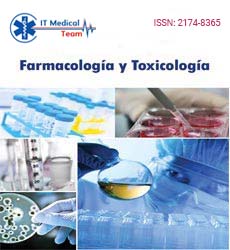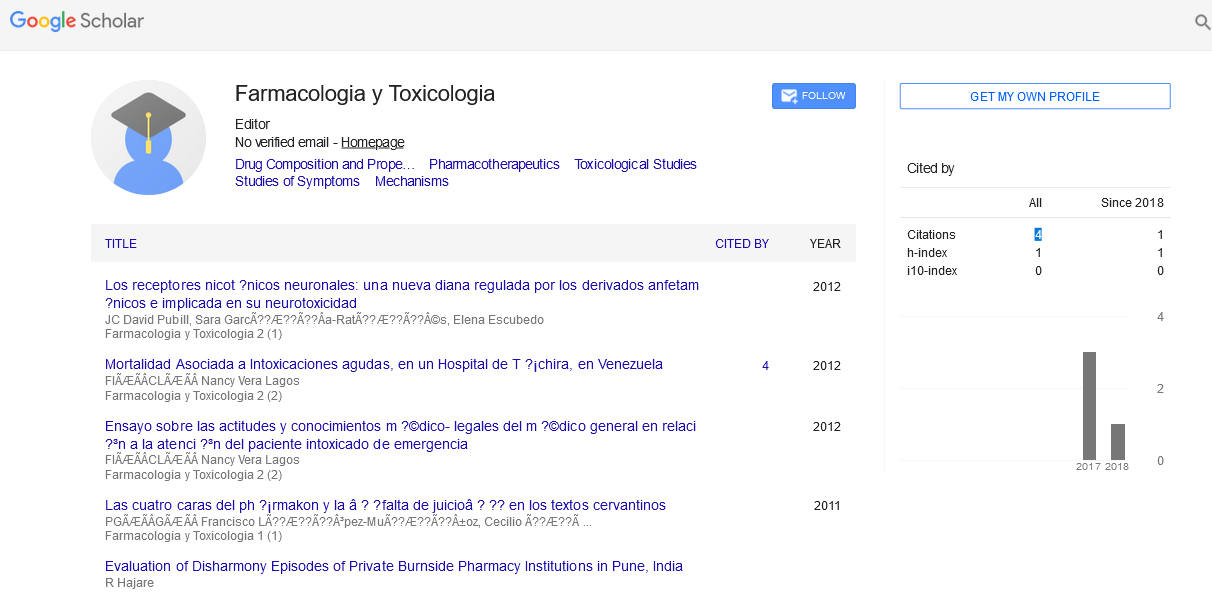Case Report - (2023) Volume 13, Issue 1
According to Person to the Citizenry: Including Birthrate Geographic Diversity in Experimental Studies of Pharmacology
Rituparna Maiti*
Health science and medicine Karolinska Institute, Sweden
*Correspondence:
Rituparna Maiti, Health science and medicine Karolinska Institute,
Sweden,
Email:
Received: 02-Feb-2023, Manuscript No. ipft-23-13472;
Editor assigned: 04-Feb-2023, Pre QC No. PQ- ipft-23-13472;
Reviewed: 18-Feb-2023, QC No. ipft-23-13472;
Revised: 25-Feb-2023, Manuscript No. ipft-23-13472 (R);
Published:
28-Feb-2023, DOI: 10.36648/2174-8365-13.1-151
Abstract
Due to a variety of circumstances, including previous and ongoing stressors, age, sex, and genetic make-up, humans react to chemical exposures differently. However, the impact of population-level variability within dose-response relationships has not been taken into account in the great majority of laboratory-based toxicity research. Risk assessment is made more difficult by the absence of information on how genetic variety affects how the body reacts to chemical exposure since everyone in the population will react differently to toxicant exposure. Notably, genetic variety is becoming increasingly important in laboratory models because it significantly influences how people' responses to drugs or chemicals vary at the population level. Here, we provide numerous assay models that can be utilised in laboratories. genetically different cell lines, human primary cells, and genetically diverse mouse panels were used to study the impact of genetic variation on an individual's sensitivity to chemicals. To illustrate the potential, viability, and strength of each of these models, we also offer a brief summary of a number of important studies. The purpose of this article is to draw attention to the significance of incorporating population-level genetic variation into toxicological study designs using laboratory-based models in order to offer and augment data for evaluating the risk that chemicals pose to the general population. As a result, taking genetic variability into account will benefit risk assessment based on human behaviour and give empirical evidence to support and guide decision-making processes in connection to chemical exposures.
Keywords
Genetic Variability, Risk Assessment, Population-Based Models
INTRODUCTION
The goal of risk assessment is to characterize the potential
hazardous nature of a chemical exposure within the human
population. Thus, knowledge of the dose-response relationship
(DRR) between any given chemical, from pharmaceuticals to
environmental contaminants, and any given physiological
response is valuable to accurate risk assessment. In traditional
toxicology studies, DRRs are established using classical laboratory
models, such as cell lines, inbred rodent, and outbred stocks that
are subject to genetic bottlenecking and colony drift [1-2]. The
results from laboratory-based toxicology studies are then
extrapolated to address the potential exposure and adverse
outcome risk within the human population. As such, DRRs are used to calculate safe-exposure limits of the respective chemicals,
such as a reference dose (RfD), acceptable daily intake (ADI), or
tolerable daily intake (ADI) Identifying the potential dangers of a
chemical exposure to the human population is the aim of risk
assessment. In order to conduct an appropriate risk assessment,
it is important to understand the dose-response relationship
(DRR) between any given chemical, including medications and
environmental pollutants, and any physiological reaction.
Traditional toxicological studies produce DRRs using conventional
laboratory models, such as cell lines, inbred rodents, and outbred
stocks that are susceptible to colony drift and genetic
bottlenecking. [3-5] The outcomes of laboratory-based
toxicological studies are then extrapolated in order to address
the risk of exposure and unfavourable outcomes in the general population . DRRs are therefore used to determine acceptable
daily exposure limits, reference doses (RfD), and other safeexposure
limits for the relevant substances. The International
Programme on Chemical Safety (IPCS) of the World Health
Organization has recommended that the tolerable exposure limit
be increased by a general overall "uncertainty factor" of 100 in
situations when interspecies and interindividual data are not
available. The uncertainty factor is divided into two groups, A)
interspecies differences, and B) interindividual differences, each
of which has a 10-fold adjustment. Two further subcategories of
the interspecies adjustment are toxicodynamics (2.5 fold) and
toxicokinetics (4.0 fold). The same categories also apply to
interindividual variances, although each category has slightly
different adjustments: A) toxicodynamics (3.2 fold) and
toxicokinetics (3.2 fold) (IPCS 2005). Without epidemiological
information on the chemical exposure and chronology of interest,
it is challenging to resolve the interspecies discrepancies, however
various Common laboratory models are not frequently used to
evaluate factors that influence interindividual variations, such as
population-level genetic variability [6]. Genetic diversity is
excluded from traditional laboratory models for the obvious
reason of reducing experimental variability. Genetic diversity will
add to the noise and, from a scientific perspective, enhance the
chance of a weak correlation within a research. The use of knockout
(KO) rodent models to determine the mechanism by which a
certain gene is causing a phenotype is a prime example of this;
the presence of genetic variation will obscure the function of the
gene of interest in the response. Mechanistic investigations
undoubtedly play a crucial part in finding the genes, proteins,
pathways, and environmental elements that contribute to specific
responses to chemical exposure and, subsequently, in developing
new treatments. possibility for creating treatments to reduce
negative consequences. They do, however, evaluate a person's
exposure and are a closed platform. Most importantly, they are
unable to evaluate the risk that chemical exposure poses to a
wide range of population. Making risk-management judgements
regarding setting acceptable exposure limits for a diverse
population is made more difficult by this data shortage.
Incorporating genetic variation into laboratory models used for
risk assessment has recently attracted increasing interest. While
numerous factors influence a person's reaction to chemical
exposure, genetic diversity has been linked to a significant
amount of the observed variation. The uncertainty factors that
were previously mentioned attempt to modify the safe exposure
limits to account for interindividual variability.The possibility that
there are sensitive people in the population who are not taken
into account by the exposure guidelines is unquestionably nonzero.
Additionally, these unknown concerns may lead to exposure
rules that are overly cautious, which could potentially hurt
industrial and municipal finances excessively. Individuals in
laboratory-based models have different susceptibilities to
chemically-induced negative health effects, just like in the real
population. For instance, many mouse strains can the exposure's
perceived danger may be altered [7]. Therefore, incorporating
population-level genetic variety into toxicity testing has the
potential to improve risk assessment of the shape of a populationlevel DRR and discover genetic variations within a population that
may be more vulnerable to a given exposure. The NRC has
released a paper titled "Science and Decisions: Advancing Risk
Assessment" that discusses the importance of including
population-level genetic variation in toxicity testing. According to
the paper, the low-dose area of non-cancer DRRs, which were
previously thought of as nonlinear functions, would be
successfully linearized if inter-individual variability prevalent in
the human population were taken into account. Notably, the
NRC's suggestion was mostly supported by theoretical evidence
and was not adequately evaluated. If put The low-dose linearity
assumption could have negative effects on the environment
when used in risk assessment. Genetic variation must therefore
be accounted for in laboratory models if risk management
decisions are to be well-informed and supported by empirical
data. In addition, genetic factors of a response to a chemical
exposure can be found by using the genetic diversity within
population-based models. Using genome wide association,
quantifiable physiological responses that differ between
individuals can be utilised to look for genomic areas that might be
in charge of the phenotypic heterogeneity. These investigations
can be used to pinpoint the genetic areas that may be responsible
for the quantitative differences between people. Previous
research has demonstrated the effectiveness of genetics-based
methods for locating genetic variants with statistically different
amounts of sensitivity to influences While these findings help to
more precisely estimate the risks associated with potential
environmental exposures, they can also reveal pharmacogenetic
variations that could affect how safe or harmful medications are
for the people being treated. In this section, we will discuss a
number of laboratory models that can produce the empirical data
required to determine the influence of genetic diversity within
DRRs and identify genetic variants and susceptible subpopulations
that may have increased susceptibility to adverse
effects brought on by chemical exposures. This data can be used
to more accurately quantify the danger of environmental
chemical exposure. Pharmacogenetic variations can also be
revealed using population-based models. Genotypes can be
utilised to anticipate a favourable or improved response to a
pharmaceutical exposure by knowing genetic drivers inside
reactions; this is at the core of the precision medicine project [8].
As a result, the models described in this article could influence
the evaluation and comprehension of a variety of chemical
exposures from the a unique member of the human race. This
article's main objective is not to argue against mechanistic
studies, but to present a number of laboratory-based models that
can be used to explain the genetic diversity found in the human
population. Regarding the heterogeneity of dose-response
interactions among the heterogeneous human population, there
is still much to discover. Thus, population-level reactions to
pollutants may be better understood using these models in
combination with laboratory-derived exposure data. Several
initiatives are shown here that demonstrate the viability of
evaluating population-level genetic variability using three distinct
biological models: genetically varied cell lines, human primary
cells, and mouse populations [9-10].
References
- Likic R, Maxwell SR (2009) Prevention of medication errors: teaching and training. Br J Clin Pharmacol 67: 656-661.
Indexed at, Google Scholar, Crossref
- Aronson JK, Henderson G, Webb DJ (2006) A prescription for better prescribing. BMJ 333: 459-460.
Indexed at, Google Scholar, Crossref
- Morrison-Griffiths S, Snowden MA, Pirmohamed M (2002) Pre-registration nurse education in pharmacology: is it adequate for the roles that nurses are expected to fulfil? Nurse Educ Today 22: 447-2256.
Indexed at, Google Scholar, Crossref
- Harden RM, Sowden S, Dunn WR (1984) Educational strategies in curriculum development: SPICES model. Med Educ 18: 284-297.
Indexed at, Google Scholar, Crossref
- Wood DF (2008) Problem based learning. BMJ 336: 971.
Indexed at, Google Scholar, Crossref
- Boreham NC, Mawer GE, Foster RW (2000) Medical students'errors in pharmacotherapeutics. Med Educ 34: 188-193.
Indexed at, Google Scholar, Crossref
- Ross S, Loke YK (2009) Do educational interventions improve prescribing by medical students and junior doctors? Br J Clin Pharmacol 67: 662-670.
Indexed at, Google Scholar, Crossref
- Moher D, Liberati A, Tetzlaff J (2009) Preferred reporting items for systematic reviews and meta-analyses: the PRISMA statement. BMJ 339: 25-35.
Indexed at, Google Scholar, Crossref
- Franson KL (2008) Measuring learning from the TRC pharmacology E-Learning program. Br J Clin Pharmacol 66: 135-141.
Indexed at, Google Scholar, Crossref
- Sauer BL (2006) Student-directed learning in a community geriatrics advanced pharmacy practice experience. Am J Pharm Educ 70: 54-56.
Indexed at, Google Scholar, Crossref
Citation: Maiti R (2023) According To Person to the Citizenry: Including Birthrate Geographic Diversity In Experimental Studies of Pharmacology. Farmacologiay Toxicologia, Vol.13 No. 1: 101.





